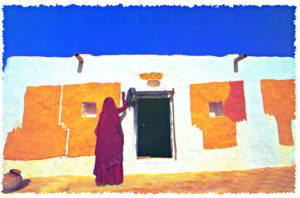
 ndia is often, and justly, described as a land of striking contrasts. The entire northern region is bounded by the mighty Himalayan ranges and some of the tallest peaks in the world, such as Nanga Parbat and Kanchenjunga 2, are to be found in India. In Indian mythology and popular belief alike, the gods and goddesses make their home on the summits of these peaks, as do sadhus and others weary of the material life. These hills have, in recent years, been rapidly denuded of their forest cover, and one can only contemplate with sadness what the loss of forests means, not only for the ecological welfare of both the earth and human communities, but for the cultural and religious ethos of Indians. It is in India’s forest communities that the Upanishadic sages developed their ponderous philosophy and wrote the forest books, and it is to the forest that Rama and Sita were exiled before they could return to claim their kingdom; it is also in the forest that one found relief from the maddening pace and fury of city life, so subtly captured by Satyajit Ray in his film, Days and Nights in the Forest. Though in general the hill regions are more scarcely populated than the plains below, an astonishingly diverse array of ethnic and linguistic communities have been settled in these regions for centuries; and just is diverse is the flora and fauna.
ndia is often, and justly, described as a land of striking contrasts. The entire northern region is bounded by the mighty Himalayan ranges and some of the tallest peaks in the world, such as Nanga Parbat and Kanchenjunga 2, are to be found in India. In Indian mythology and popular belief alike, the gods and goddesses make their home on the summits of these peaks, as do sadhus and others weary of the material life. These hills have, in recent years, been rapidly denuded of their forest cover, and one can only contemplate with sadness what the loss of forests means, not only for the ecological welfare of both the earth and human communities, but for the cultural and religious ethos of Indians. It is in India’s forest communities that the Upanishadic sages developed their ponderous philosophy and wrote the forest books, and it is to the forest that Rama and Sita were exiled before they could return to claim their kingdom; it is also in the forest that one found relief from the maddening pace and fury of city life, so subtly captured by Satyajit Ray in his film, Days and Nights in the Forest. Though in general the hill regions are more scarcely populated than the plains below, an astonishingly diverse array of ethnic and linguistic communities have been settled in these regions for centuries; and just is diverse is the flora and fauna.
To the British, the mountains represented preeminently an escape from the sweltering heat of the plains, and to this day, the Indian middle classes’ only association with the mountainous regions of India is as places of retreat for the family. The “hill station” remains an enduring legacy of British rule in India today, as witnessed by the droves of middle-class Indians that repair to Dehra Dun, Mussoorie, Nainital, Dalhousie, Shimla, Darjeeling, and numerous other hill stations during the summer months.
If the Himalayan peaks form an indelible part of the Indian imagination, so do the vast Gangetic plains and the numerous rivers of India. Civilizations began around rivers and deltas, and rivers remain an enduring icon of national culture: as the name of London conjures up the image of the Thames, so one undoubtedly associates Egypt with the Nile. The Punjab, as every schoolchild in India is aware, is the land of the Five Rivers. In India, it has been argued, this association is even more compelling, as rivers are not merely great carriers of goods, passageways to the beyond, and the source of life and sustenance for millions, but harbingers of fertility and repositories of the sacred. The recent and continuing struggles over the attempts to construct a series of large dams along the Narmada testify to the deep feeling that Indians have for their land and rivers. Most of India’s rivers, such as the Narmada, Yamuna, and Saraswati, have given rise to vast realms of lore, none more so than the Ganga, known to the West as the Ganges.
Originating high in the Himalayas, at the Cow’s Peak (Gaumukh), the Ganga flows through the plains and empties out in the Bay of Bengal. The holiest Indian cities, from Hardwar to Banaras, grew along the banks of the Ganga, and the dying Hindu, or so the anthropologist tells us, wishes for nothing more than a sip of Ganga jal (water) as the breath fades away from his or her life. It is not only the Ganga, nearly half a mile wide at some points, as it forks through the plains, but the bathing ghats at Banaras and Hardwar, the pilgrimage centers further north, and the teeming metropolis of Calcutta, which constitute the landscape of India. In the south, the terrain once again changes, and here the land is bounded by the water.


